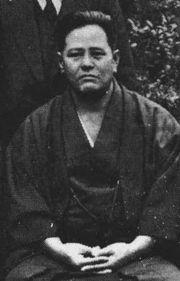
Chōjun Miyagi (宮城 長順, Miyagi Chōjun?,
April 25, 1888�October 8, 1953) was born in Naha, Okinawa and was the
adopted son of a wealthy businessman. Miyagi began his study in karate
at the age of nine (or eleven). He first learned martial arts from Ryuko
Aragaki, who then introduced him to Naha-te Master Kanryo Higashionna
when Miyagi was 14. Under the tutelage of this Master, Miyagi underwent
a very long and ardous period of training.
After the death of Master Kanryo
Higashionna, Miyagi travelled to Fukien Province in China as his teacher
had done before him. In China he studied the Shaolin and Pa Kua forms of
Chinese boxing. From the blending of these systems, the hard
linear/external form of Shaolin, the soft circular/internal form of Pa
Kua, and his native Naha-Te, a new system emerged. However, it was not
until 1929 that Chojun Miyagi named the system
Goju-ryu,
meaning hard-soft style.
After some years in China, Chōjun Miyagi returned to Naha where he
opened a dojo (training hall). He taught for many years, and even though
Miyagi's reputation as a karate man was enormous, and even Kano Jigoro,
the founder of judo, came to Okinawa to learn specific karate takedowns,
his greatest achievements lie in popularization and the organization of
karate teaching methods. He introduced karate into Okinawa police work,
high schools and other fields of society. He revised and further
developed Kata Sanchin - the hard aspect of Goju, and created Kata
Tensho - the soft aspect. These kata are considered to contain the
essence of the Goju-ryu style. The highest kata, Suparimpei is said to
contain the full syllabus of Goju-ryu kata. Shisochin was Miyagi's
favorite kata at the end of his years. Tensho was influenced by the
White Crane kata Ryokushu, which he learned from his long-time friend
Gokenki. With a goal of unification of various karate styles which was
in fashion at that time (see Funakoshi Gichin for his works in Japan),
he also created more Shurite-like katas Gekisai Dai Ichi and Gekisai Dai
Ni in 1940, taking techniques from higher forms (notably Suparimpe also
upper block was uncommon for Goju-ryu at that time) and incorporating
them into a shorter forms. It is said he created these kata to bridge
the gap between Sanchin-kata and Saifa kata, which contains much more
complex moves compared to Sanchin kata. However, Gekisai katas are
learned before Sanchin-kata now.
Chōjun Miyagi was a man of extremely mild temperament and it is said
that he was a very humble man. He lived according to the principles of
martial arts, that of non-violence. Master Miyagi died in Okinawa on
October 8, 1953 from second heart-attack (first took place on 1951).
Some of his more notable students were Seiko Higa (also a student of
Kanryo Higaonna), Seikichi Toguchi (founder of the Shorei-Kan dojo),
Ei'ichi Miyazato (founder of the Jundokan dojo), Meitoku Yagi (founder
of the Meibukan dojo, he eventually accepted late master Miyagi's gi and
obi from Miyagi's family), and in Japan, Gogen Yamaguchi (founder of
Goju-kai and who, after short training with Miyagi, spent later most of
his time studying katas under Meitoku Yagi while being himself a
representative of Goju-ryu in Japan).




